Witness Recounts Massacre of Cham at Trea Village
Today, Cham witness Ahmad Sofiyah recounted how she and thirty-five other Cham girls were detained in Trea intVillage, 20 of whom were killed after having said that they were children of Cham or mixed families. She told the Court that she witnessed how Khmer Rouge decapitated the victims. Another Cham – No Satas – had been detained with her and had talked about the same incident, but had not witnessed the executions themselves.
Background
At the beginning of the session, the Trial Chamber President Nil Nonn announced that Judge You Ottara was absent for personal reasons. He was replaced by Thou Mony. Judge Karopkin was absent for health reasons. International Civil Party Lead Co-Lawyer Marie Guiraud was also absent for personal reasons. All other parties were present.
Ahmad Sofiyah, shortened to Mad So, was born in 1961 in Khsach Prachhes Kandal Village, Krouch Chhmar commune, Krouch Chhmar District, Kampong Cham Province, where she also resides today. She is mother of nine children and Muslim. She then took an oath before the Chamber. She said that the Written Record of Interview were not always accurate but in general rather consistent.
The floor was then granted to the Co-Prosecution.
National Deputy Co-Prosecutor Seng Leang started his line of questioning by inquiring about where she was located before the arrival of the Khmer Rouge in her commune. She answered that she was working in the cooperative in the rice fields. She said the Khmer Rouge came to control her area in 1978. Mr. Leang asked whether this was correct or whether they took control maybe already in 1975 or even earlier. She denied this and insisted that it was in 1978. Mr. Leang asked when the Lon Nol regime fell, which she could not recall. She was in Khsach Prachhes Kandal Village when the Khmer Rouge took power, before being evacuated. She said that they tried to kill them in 1978. She confirmed that the Khmer Rouge were already in her area in 1975. She did not know how many families lived in the village at the time. To refresh her memory, he referred to her Written Record of Interview, in which she had said that she was 14 years old when the Khmer Rouge arrived and they had ordered her to stop studying.[1] Mr. Leang asked whether it was correct that she was born in 1960. She corrected it to “maybe 1961”. He asked whether they arrived therefore in 1975. She was unsure.
He then turned to the living conditions in Khsach Prachhes Kandal Village and asked how they were before the Khmer Rouge arrived. Mr. Koppe interjected and said that it seemed that the area had been under control of the Khmer Rouge already in 1970. The National Deputy Prosecutor, according to Mr. Koppe, should be more accurate with regards to historical facts. As for Cham families between 1970 and 1975, she said that people in her village were all evacuated. Mr. Leang said that it was before the Khmer Rouge took power in the country and asked when the evacuation took place. She said that she was too young to remember the time that they were evacuated.
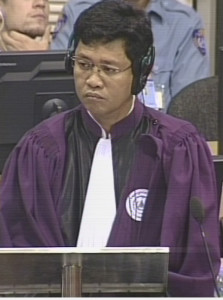
National Deputy Prosecutor Seng Leang
Mr. Leang then asked what the occupation of the villagers – particularly of the Cham – was between 1970 and 1975. She replied that they were “evacuated away” and “faced suffering.” She could not remember the year, but they “were ordered to cut our hair short and our religious practices were abolished.” Mr. Leang inquired whether they were allowed to practice Cham religion, wear Cham clothes or speak the Cham language before the evacuation, which she denied: “We were all ordered to wear black clothes.” He then asked whether the living conditions of the Cham people were better or worse from the evacuation onwards. She replied that they were ordered to grow trees and sugar cane trees and only ate porridge. “The situation was very difficult.” They were ordered to speak the Khmer language. As far as she could remember, they were allowed to wear their traditional clothes and wear their hear long before this. He then asked whether the living conditions became harder during the Khmer Rouge regime, which she confirmed. Other people were not evacuated from her village after the evacuation of the Cham. “There were only Khmer people brought into my village.” She did not know how many families there were in the village.
Mr. Leang asked whether she was familiar with a woman called No Satas. She replied that she did. “Now she lives in Svay Khleang.” She was in her mobile unit. “Then we were all evacuated to Trea II”, which was the place where “they had the plan to kill us.” She could not remember when this took place.
Detention at Trea Village
She could not remember the month and year when the Southwest cadre arrived. Mr. Leang wanted to know whether the living conditions of Cham people became more difficult after the arrival of the Southwest cadres, which Ms. Sofiyah confirmed. “We faced a lot of suffering and hardship.” It was difficult in “all aspects”, including eating. They were separated from their parents. When Mr. Leang asked “what they did” to identify who were Cham and who were Khmer, Khieu Samphan Defense Counsel objected and said that they had faced a “series of leading questions.” Mr. Leang replied that he had only asked how they identified the Cham people and Khmer people. The objection was overruled. She replied that they were asked who of them were Cham and who were Khmer when they arrived at Trea II Village.
When Ms. Guissé stood on her feet, Judge Claudia Fenz said that the question was open and that it might have been a translation issue. Ms. Guissé answered that she had not heard the witness talk about the separation of Cham and Khmer people, but since no one else seemed to have a problem with that, she would sit down again.
Mr. Leang then referred to No Satas’ testimony: Ms. Satas had said that the village chief identified the Cham people.[2] Ms. Sofiyah confirmed to this statement. Ms. Guissé objected again to the way the questions were posed. The President said that the information in the statement of another witness could not be given “straight to a witness”.
Mr. Leang moved on and asked whether she was in a mobile unit, which she confirmed. She could not remember when this took place, but by the time she returned, her parents had disappeared. He asked what she observed when she returned to her village, especially with regards to the number of Cham that remained in her village. She replied that she could not recall this. She said that there was a plan to kill them all.
She recounted that after she returned from the mobile unit, her mother and father were called. There was a second group, in which the women were called. The men were sent first. They were told that the men would build houses for them. They were told that they would go to Koh Samraong, but went to Trea II Village instead. When they arrived, there were around 30 Cham people who were “placed in the house”. She was part of the group. These were the mobile unit members. The house was a detention house. It was around 4 o’clock when they arrived. It was not dark yet. She saw them sharpening a knife. They were instructed to go to the house. “Then they closed the windows and the door.” Some armed people were standing next to the house. “We were not allowed to get out of the house.” She further said: “When the night was about to fall, they stripped some pieces of clothes. [..] They instructed us to be tied up. The 30 of us did not know how to react. We only looked at each other and kept quiet. And then they tied us all up.”
As for the sharpening of the knives, the people told them that “tonight we have some big pigs”, so they told them that they needed to sharpen their knives.
She was not tied up yet, but told them so, since she did not know how to flee. There were a lot of armed people outside, so she did not know how to flee.
At this point, the President adjourned the hearing for a break.
Separation of Cham from Khmer
Mr. Leang resumed his questioning and returned to the evacuation to Trea Village. He asked whether it was correct that the Khmer Rouge came to the house and wanted to tie her up, which she confirmed. He asked whether they did anything else, which she denied. He asked whether the interrogated “all the people on the house”. She replied that when they had tied them up, they interrogated them and asked how many of them Cham and how many were Khmer. Mr. Leang inquired how she answered and how the other people in the house answered. She recounted that they asked how many of them were children of mixed marriages. Those who answered that they were children of mixed marriages were put in one group. She first said that she was a child of mixed marriage, but was “fearful” later and told them that she was a child of Khmer people. Those who said that they were children of mixed marriages were taken away. “Of the 30 people in the house, around 20 people were taken away to be killed.” There were only people from her group in the house and no other people.
Mr. Leang asked what happened next after having given answers. She answered that after the people gave the answer, “those who were taken away were told that they would be taken to eat somewhere else and I had no knowledge of what happened next to them.” Mr. Leang asked where the two groups of people – the ones who said that they were Cham or mixed marriages – were taken to. She replied that they were taken to be killed. Ten of them told them that they were children of Khmer people. “They took away only Cham.” Mr. Leang asked how she knew that the two other groups were taken away to be killed. Mr. Koppe objected and said that she also had specifically said that she had no knowledge about what happened next to the two other groups. Mr. Leang replied that he based his question on her previous answer. The objection was overruled. Mr. Leang repeated the question. She recounted that they “saw them through the holes of the walls and saw them [being] taken away.” Mr. Leang asked whether the Khmer Rouge “did anything else” to the Cham and children of mixed marriages before the killing. Mr. Koppe objected to the term “killing.”
Mr. Leang asked whether it was her statement that the two other groups were taken away to be killed, which she confirmed. The President said that the Prosecutor would have to ask in another way, such as asking how far away she was and the like. She recounted that the other two groups were taken two a pit around eight meters away. They were killed there. There were some tamarind trees there. “I saw the events unfold.” Mr. Leang then wanted to know what happened to the group that answered that they were Khmer. Ms. Sofiyah said that the ten of them were given a bowl of gruel. Mr. Leang then gave the floor to his international colleague Nicholas Koumjian.
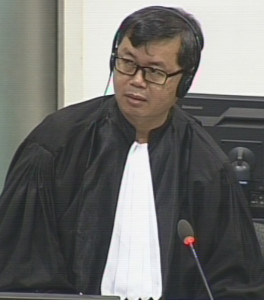
National Khieu Samphan Defense Counsel Kong Sam Onn
Mr. Koumjian inquired whether the 30 people in the house were all from one area or from different areas. She replied that they all came from the same area, namely from Khsach Prachhes Kandal. Mr. Koumjian wanted to know whether Ms. Sofiyah knew the thirty girls or women before. National Khieu Samphan Defense Counsel Kong Sam Onn interjected and said he had not heard her saying that they were all girls.
Killings
Mr. Koumjian repeated the question. She replied that she knew them; some of them were her family. “They were all familiar to me. […] They were not strangers.” Mr. Koumjian asked whether he ever saw those who were Cham or of mixed blood again. She answered that she had told them that she was Khmer in order to survive. Mr. Koumjian repeated his question. She said “no, I did not see them again, because they were killed into the pits.” She could see outside of the house, because there was a window and she could see through the holes of the window. They ordered people to stand close to the pits, where they were sent to.
Mr. Koumjian asked her to recount the events in as many details as possible. She replied that he heard the scream “please don’t rape me”, but did not see the actual rape. It was a full moon night, so she could see the pits. “There were no trees blocking my view. So I could see the pits clearly.”
Mr. Koumjian wanted to know whether anyone arrived at the house after that night. She stayed at the house for 24 hours and then left eastwards. Ms. Sofiyah recounted that there were no new people coming into the house, but some new people were kept in front of her house. She did not know where the people who were kept in front of the house were sent to next. The house was around eight meters away from the river and around 100 meters away from the pits. “Now that area has already fallen into the river.” Mr. Koumjian asked whether she saw anyone being killed that night. She said that she did, but “I was a little bit far away from the pits.” She saw them falling into the pits. The pit was big, but shallow. She did not dare to approach the pits, since she was still tied up. Hor was in charge of the house.
She did not know from which village Hor came. She knew that he was called Hor, because his colleagues called him by the name. By her understanding, he was chief of the district. He was tall and “had a broad, bold forehead and a rather long face.”
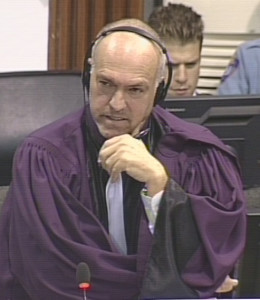
International Co-Prosecutor Nicholas Koumjian
Mr. Koumjian asked why she had said that there was a plan to kill all the Cham. She said that she did not know about this. “I was wondering why they took the Cham away and killed them. I still have no answer for that.” She did not know any Cham from her village that survived the regime. All her family members were taken away and killed. There were eight family members. She lost six siblings, her father and her mother. Two of her elder sisters were pregnant.
She went to school when she was 14 years old. Her siblings were taken away and killed and she was not allowed to study anymore. Her teacher was Khmer and they studied Khmer. Mr. Koumjian wanted to know whether anyone taught her how to pray or taught her the Arabic language, which she confirmed. Her parents taught her the Islamic religion and she studied the Khmer language in the school. She knew a hakim called San in her village, who was taken away and killed.
Mr. Koumjian asked whether anyone of the women or girls in the house at Trea Village were planning to overthrow Pol Pot or capture Phnom Penh, which she said they did not. “I did not know why they were taken away and killed.” Neither did her parents have any plan to overthrow Pol Pot. Mr. Koumjian then gave the floor to the Civil Party lawyers.
Civil Party Co-Lawyer Lor Chunthy asked which village she was living in 1975. She said that she lived in Khsach Prachhes Kandal Village. Her husband was from Trea Village. There were not many Cham people living in this village. The majority were Khmer. In the area, only her family was Cham, while the rest was all Khmer. When she returned, all people who were evacuated to live in her village were Khmer. When they were evacuated, they – her parents and her – were evacuated to Krouch Chhmar Kraom. They were allowed to live as a family, but she had to work in a mobile unit.
He asked whether male members were sent first during the evacuation. She said that “we were all sent.” However, when they were relocated back to their village, they were put into separate groups. Men were told to build houses for women. The women were sent afterwards.
Mr. Chunthy then inquired where the men were sent to build the houses. She replied that she did not know about this. The men were sent on the first day, and women on the second day. Her group was on the third day. When the men were taken away, they were being walked into the direction of Krouch Chhmar. The second group was sent to be gathered up in front of Khsach Prachhes Kandal Pagoda and put on boats. She did not know where they were sent to.
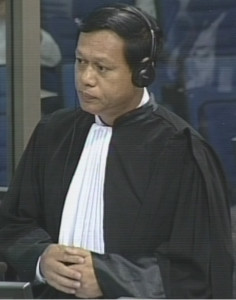
Civil Party Co-Lawyer Lor Chunthy
The third group was asked to walk to Trea Village. It took them a little bit more than an hour to reach the village. Most of the people were older than her. She was the youngest member of the group. Mr. Chunthy asked how she knew the name of Trea Village. She replied that she knew the village, because it was adjacent to Khsach Prachhes Kandal. Her group consisted of more than 30 people, maybe around 35 or 36. The whole group was placed in the same detention house. Only later were they divided.
Mr. Chunthy asked whether she observed anything special regarding the house. There was not. There was a group of soldiers next to the house “who were sharpening their knives.” This happened in late afternoon. When the sun was about to set, her group was tied up. She saw them sharpening the knives through the door of the house. The knives were those that were used for rubber trees. They were sharpening their knives in another house next to where they were.
Mr. Chunthy then wanted to know how many Khmer Rouge came to tie them up. She replied that there was a woman who went up to the house with strips of cloths. Later, three men came in. There were several of them under the house who had guns. After tying them up, “they shouted whether everyone was tied up.” She further recounted: “I was afraid of being tortured and I said that I was not tied up yet. And they said I was a good girl.” Mr. Chunthy asked whether the persons who asked them whether they were Khmer or Cham took notes. She replied that she saw them carrying a notebook and a pen, but she did not know whether they wrote down the information. They took one or two people at the time out of the house. She did not know the woman. The only person she knew was Hor. He went up the house.
Witnessing the killings
Mr. Chunthy then inquired how the killing was carried out. She replied that one or two people at a time were taken away to have a meal, but were killed instead. She could see the killing through the holes in the wall. “They placed a wooden plank next to the pit.” Next, they were asked to kneel down. Next, “They beheaded them and they fell into the pit.” Mr. Chunthy asked whether the rest of the group also witnessed the killing. She said that she did not know whether everyone in the house saw the killing. “I could only say about myself, because I had a look through the crack of the wall.”
Mr. Chunthy then inquired whether No Satas was next to him while being in the house. She answered that No Satas was in the group, but she could not tell him whether she was in front, behind, to the left or to the right of her. The next morning, they were taken out of the house and placed into another house to the east. “That morning, they actually killed a pig and instructed us to eat. However, I could not eat the pork and only ate the soup and vegetables.” Mr. Chunthy wanted to know whether they said anything to her when they killed the pig and gave them soup. She replied that they did not say anything.
Turning to his last question, Mr. Chunthy wanted to know whether she could tell the Chamber about her feelings concerning the loss of her family members. She answered that “I of course feel much pain. But I could not do anything. And I had to turn to religion. If that was the end of their fate, I could not do anything. Of course I felt great pain for my parents and my elder pregnant sisters.”
The President adjourned the hearing for a break.
Other witness’s accounts of the incident
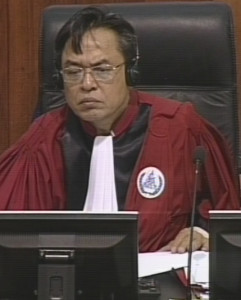
Trial Chamber President Nil Nonn
After the lunch break, the President announced that Judge You Ottara was present in the courtroom now. He further announced that with regards to witnesses 2-TCW-894 and 2-TCW-938 oral submissions would not be heard now.
The floor was then granted to the Nuon Chea Defense Team. International Defense Counsel Victor Koppe started his line of questioning by asking how well Ms. Sofiyah knew No Satas and asked whether they had worked in the same mobile unit before being sent to Trea Village in 1978. Ms. Sofiyah confirmed that they worked in the same mobile unit in Krouch Chhmar District in Kampong Cham Province. They went together when they were evacuated. They separated from each other after having survived the Khmer Rouge regime. She knew her when she worked in the mobile unit.
Mr. Koppe then asked whether she knew a woman called Tam Rahima, also known as Chhuk. She said that the woman lived in the same village as herself. She worked in the same mobile unit as her. Tam Chhuk survived the regime. Mr. Koppe asked whether she was also taken to Trea Village to the house where they were detained. Ms. Sofiyah confirmed this. Mr. Koppe asked whether she recalled if Tam Chhuk’s older sister was also detained in the same house, which she also confirmed. “But she was taken away to be killed. She was amongst the probably 30 people who was taken away from the house to be killed.” Mr. Koppe asked whether Tam Chhuk was able to “look through that crack in the wall”. Ms. Sofiyah did not know this. Mr. Koppe asked whether Ms. Sofiyah told the other girls in the house what she saw. She replied that she did not “because we were all panicked”. Mr. Koppe whether it was her testimony that she was the only person who saw this and kept it to herself. At this point, Civil Party Lead Co-Lawyer objected and said that this would lead to speculation whether the other people had seen the events. Judge Fenz instructed Mr. Koppe to divide the question into two parts. Mr. Koppe asked whether she knew if there were other girls who also tried to see through the cracks in the wall. She said that no one else tried to look through the cracks in the wall.
Mr. Koppe explained that No Satas told the investigators that she had not witnessed any executions with her own eyes, despite having said earlier that she did see executions.[3] Tam Chhuk, according to Mr. Koppe, did not mention having witnessed any executions either.[4] Mr. Koppe asked Ms. Sofiyah to give a reaction. Mr. Koumjian interjected and said that this led to speculation, since the witness had said that she was the only one who looked through the cracks. Mr. Koppe said that this was a legitimate question. Judge Lavergne asked Mr. Koppe that he could not see the contradiction between what she had said and what the other witnesses said.
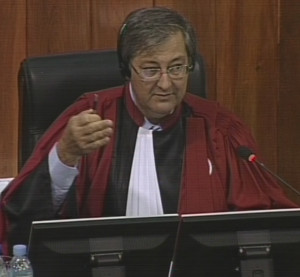
Judge Jean-Marc Lavergne
“It is the position of the defense that she hasn’t actually seen anything through the crack od the wall” Mr. Koppe said that it was legitimate to ask her to give an explanation why the other two witnesses had not seen the executions. Judge Lavergne said that he had the explanation already.
Mr. Koppe moved on and that he was about the number of people that were in the room and the number of people how many were taken away to be killed. He said that she had suggested in her Written Record of Interview that there were only ten girls who had to leave and were taken away. Ms. Sofiyah replied that twenty among the 36 were taken away, and 16 survived.
Mr. Koppe referred to her Written Record of Interview, in which she had said that around ten girls were taken away, which was consistent with what No Satas had said.[5] Mr. Koumjian interjected and said that he interpreted what No Satas had said differently. She had said that after ten women were taken away, they were given gruel. This did not preclude further people being taken away. Ms. Sofiyah said that she could not comment on the answer No Satas had given. Her own witnessing. “No Satas did not communicate with me. She did not tell me that ten were taken away to be killed.” She then repeated that around 20 people were taken away. “I hope this is clear for everyone.”
Answering a question, she said that they did not ask her about her full name. They only took note of the total number of the Cham people, Khmer people and those of mixed blood. No one was asked names. Mr. Koppe asked whether Tam Chhuk and her older sister were also not asked their names. Ms. Sofiyah replied that she did not know, since they were questioned individually.
This prompted Mr. Koppe to read out an excerpt of her interview she had given to Ysa Osman.[6] She had said that they asked her about her name and that she answered truthfully about what her name was. She replied that this was the statement she gave Ysa Osman. “The statement that you quoted might be my confusion.” She said that she did not tell them her name, but she told Ysa Osman her real name Ahmad Sofiyah. She said that Ysa Osman might have made a mistake when taking notes. She did not tell the Khmer Rouge her real name.
Mr. Koppe then referred to No Satas’ testimony, in which she had said that she had given a false name during the interrogation.[7] Tam Chhuk also said that they questioned her in detail. Mr. Koppe asked whether she was sure that they never asked her about her name. Ms. Sofiyah asked whether he was asking about the Khmer Rouge, which Mr. Koppe confirmed, and then said that she did not tell them her name. She said that she used another name, that is Raen, and she did not tell them her real name. Mr. Koppe asked whether this was because Ahmad Sofiyah was a name that sounded like a Cham name.
Mr. Koppe asked whether cadres went to check and verify the information she had given in the districts and communes the next day. She asked which cadres he was referring to. She said that it seemed that no cadre went to verify her information and that she was interviewed twice: once in Trea Village and once in Kampong Cham. She did not give a clear answer to the question.
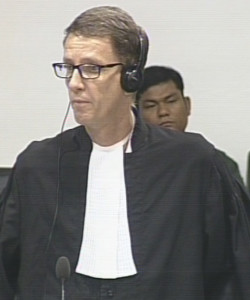
Nuon Chea Defense Counsel Victor Koppe
Mr. Koppe said that No Satas had said that the cadres verified the information they had given. She said that she did not know what No Satas said, since she lived in a different village.
Mr. Koppe asked whether she was the only one who heard something about possible rapes of girls who had just been taken away. This prompted Mr. Koumjian to interject and said that this led to pure speculation: “how does she know what other people heard.” Mr. Koppe rephrased the question and asked where she was when she heard the plea not to be raped. She replied that she heard it through the crack of the walls. “I saw them being killed and I heard shouting from those women, begging them not to rape.” However, she did not see any act of raping. Mr. Koppe asked whether she was able to tell if you could hear it anywhere in the house or only if you were really close to the wall. She replied that she did not know, because the house was pretty big. Mr. Koppe asked whether she did not have any explanation why Tam Chhuk never talked about any incident of rape.
Mr. Koppe asked whether No Satas told her what questioned she was asked. She replied that she did not know about the questions put to No Satas. Mr. Koppe said that No Satas had said that she was asked whether she was Vietnamese. No Satas had also spoken about the difference in treatment of Cham from the east bank and the north part of the river.[8]
Mr. Koppe wanted to know whether Ms. Sofiyah knew anything about this, which she did not.
Mr. Koppe asked how she knew Hor before entering the room of the house. She said that she knew that he was Hor when she was detained. He came to talk to them, the 16 surviving people, at the other house. She got to know him during the detention. Mr. Koppe asked what else she knew about him. She said that she only knew his name and that he was a chief. She knew he was a chief, because he was in charge of the subordinates. Mr. Koppe wanted to know how she knew that he was the district chief. He asked whether it was possible that he was the chief of the unit there. She replied that she heard people referring to him as Chief Hor. She did not know more about this. Mr. Koppe asked whether she knew if the person was still alive or whether he was dead. She replied that she did not know whether he was still alive or dead.
Mr. Koppe asked her for a reaction that No Satas seemed to know that Hor was dead. Mr. Koumjian objected. Mr. Koppe rephrased and asked whether she had ever heard if Hor was dead. She replied that she did not know.
Rebellion
Mr. Koppe turned to his last topic and inquired about a rebellion in her village in October 1975. She replied that she did not know anything about other villages. She did not know what the intention was to line up every member of houses in front of their houses that she had seen at some point. She said that she was only fourteen years old at the time and did not know much about rebellions at other places.
Mr. Koppe referred to No Satas’ hearing. She had said that she had heard about the White Khmer Movement and that arrests had been root causes for a rebellion.[9] Mr. Koppe asked whether she had ever heard about an involvement of White Khmer Movement with a rebellion. Ms. Sofiyah answered that she had no knowledge about this. Neither did she know about armed forces. Mr. Koppe then asked whether she had ever heard about armed conflict any time in 1977 or 1978 near her area, which she had not. Mr. Koppe then gave the floor to his national colleague.
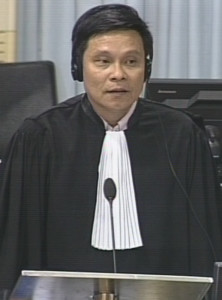
National Nuon Chea Defense Counsel Liv Sovanna
Mr. Liv Sovanna asked when she was married. She replied that she was married when she was 17 years old. There were 70 couples in the wedding. They arranged tables and put flowers. Her husband’s name was Sos Mat. He is Muslim. They knew each other from their time in the mobile unit. “He knew me and he proposed marriage with me.” Thus, their marriage was arranged. She confirmed that their marriage was a result of the proposal by her husband. Her father-in-law was still alive at the time. After the ceremony, her parents-in-law and she fled into the forest. She fled together with her parents-in-law.
He then asked whether there were any other Cham people who fled into the forest, which she confirmed. “There were a lot of Cham, but there were also some Khmer people mingling among us.” Ms. Sofiyah did not know how many Cham there were in the forest. They fled to avoid the arrests by the Khmer Rouge cadres. As for her marriage, she did not know anything besides the fact that her husband had proposed to marry her. She knew that he was Cham, and it were not the villagers who told her. He did not tell her whether he hid his identity.
Inside Trea Village
After the last break, Ms. Guissé turned to Ms. Sofiyah’s arrest in 1978. She asked who arrested her. Ms. Sofiyah said that they were told to go to harvest rice at Koh Samraong, but were sent to Trea Village II instead. The cadres from Hor’s group told her this. She referred to the same persons as those who came to the house. She could not tell the Defense Counsel how many men and women there were.
She asked whether she understood it correctly that there were three persons in the house at Trea. Ms. Guissé asked whether it was correct that there were three men and one woman, which Ms. Sofiyah confirmed. She asked whether these were the same person who also came to fetch her at the village. She replied that they were told to go there by people in the village. She did not know the persons who told her to go, but it was a different group than the group that tied her up.
Ms. Guissé then asked whether she understood it correctly that there were no other people from other villages who joined them at their house. Ms. Sofiyah confirmed this.
Ms. Guissé then asked whether other people joined them in the second house they were relocated to. She said there were only the 16 people. She stayed in the second house for around five days. She was sent to her mobile unit and to the Krouch Chhmar office after the five days. The office had a pile of clothes which were from the people who were killed. The 16 people were sent to gather and to collect those clothes. Ms. Guissé asked whether No Satas joined her to fetch the clothes, which Ms. Sofiyah could not recall.
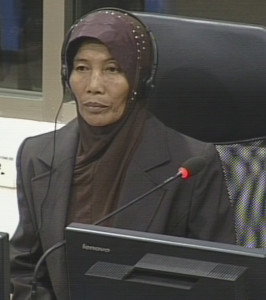
Witness Ahmad Sofiyah alias Mat So
Ms. Guissé then asked her to describe the house at Trea. The house was “pretty large” and stood on wooden poles. The house was removed by the time the investigators asked her to show it to them. She clarified that the pits were eight meters away from the house and not hundred. The house was in the middle of the riverbank and the pit. They were on their feet when they were tied up and afterwards they sat down. The window in the house was located on the West side. However, they would pray to the west side in Trea Village. Maybe this was known as to the north. She moved closer to the window so that she could see through the crack. Initially, she was sitting rather far from the window, but moved gradually when people had been taken out of the house. There was a three fingers thick plank that fell off the window. The executions took place around 7 o’clock, since it happened a while after the sun set. The girls in the house did not dare to talk. “I was terrified when I saw quite a large number of soldiers. Ms. Guissé asked whether the people who were in the house could hear what was happening outside. At this point, Mr. Koumjian objected on the same grounds as before. Ms. Guissé rephrased her question and asked whether she could hear the cries, because the house was quiet. They talked quietly when they took two of them outside. She talked to the remaining 15 people, because she saw the executions. She had looked outside the window, since there were family members in this group.
Ms. Guissé asked whether she spoke to the young girls about what she saw or not, since she had said that she did not this morning, and said that she did just now. At this point, Mr. Leang objected and said that he did not hear the witness say that she had told the other girls about the event. The witness clarified that she did not tell anyone.
Ms. Guissé asked whether she described the scene to anyone she saw to anyone afterwards, which the witness denied. “I was scared about my own life, so I did not tell anyone.” Neither did she anyone else afterwards. She could not recall the date when Ysa Osman interviewed her.
Ms. Guissé asked whether it refreshed her memory if being told that it took place in 2003.[10] Ms. Sofiyah replied that the interview took place, but she could not recall the year. She saw Osman once in Kampong Cham.
Ms. Guissé then asked whether she remembered having given corrections to the investigators about the interview she had given to Ysa Osman, which Ms. Sofiyah denied.
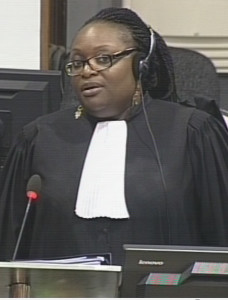
International Khieu Samphan Defense Counsel Anta Guissé
Ms. Guissé referred to No Satas’ testimony.[11] She had said that 300 people in the house. Ms. Sofiyah insisted that there were only 36 people in the house. They were all sitting together when Hor interrogated them. He interrogated all of them as one group. Ms. Guissé said that she had testified that she did not know which questions were put to No Satas. Did this mean that she could not remember the questions put to No Satas? She said that she did not know which questions were put to No Satas. She only knew the questions that were put to them when they were assembled as a whole group.
Ms. Guissé asked whether she remembered other girls that were present in Trea and followed to Krouch Chhmar afterwards. She replied that some of them had already passed away now. She named a few persons, for example Nha, Sra Ey, Mat So, Sa Ro, Ta Yom.
Ms. Guissé confronted her with her own Written Record of Interview – she had indicated a different distance.[12] Ms. Sofiyah stood by her statement that the distance was eight meters between the house and the pits.
Marriage
Ms. Guissé then asked whether he had known her husband before leaving for Trea or afterwards. She confirmed that she met her husband in Krouch Chhmar after the incident where people were taken away to be killed. Ms. Guissé asked whether her husband’s family originally came from Krouch Chhmar, since her father-in-law came to ask for his son’s marriage. She said that they came from Trea II Village. They asked her whether she was interested in marriage and she said yes. When Ms. Guissé asked who asked her this, she said that they did not ask her. The marriage was simply organized. They were asked to hold hands and then they were married. The wedding took place in Trea II Village. Hor did not attend the marriage ceremony, but member of his unit did.
Ms. Guissé wanted to know why Ms. Sofiyah fled. She replied that after they fled after the marriage, because they heard the rumor that “those 70 couples who were just married were taken away to be killed.”
Ms. Guissé referred to Ms. Sofiyah’s testimony, in which she had talked about fetching clothes.[13]
She got married when she came back from fetching the clothes in Krouch Chhmar, in which she had found her parents’ clothes.
Ms. Guissé asked how she could identify these clothes, since they were not allowed to wear traditional clothes. She replied that this was correct, but when she found the clothes, she kept a few of them to keep the family heritage. “I brought with me only two shirts.” The clothes were not in her house. The parents were assembled in front of a pagoda when they removed the clothes. They put the clothes into a warehouse.
Ms. Guissé pointed out that she had said in her interview that she fled with her husband immediately after seeing the clothes and that Hor had organized their wedding. The witness clarified that Hor organized the wedding but was not present himself.
As for the clothes, she was not yet married yet. The wedding took place later. The extract had also stated that she was seven months pregnant. Ms. Guissé wanted to know how long before the arrival of the Vietnamese she got married. She replied that she got married after having gone to fetch the closes. They fled to the forest later. At this time, she had morning sickness because she was pregnant. When they left the forest, she was seven months pregnant, so she assumed they stayed in the forest for a long period of time.
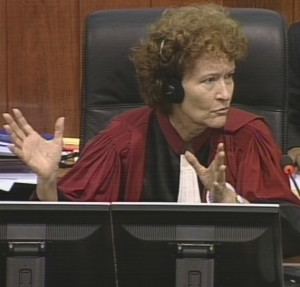
Judge Claudia Fenz
Judge Fenz took the floor. She asked whether the wedding took place sometime in late 1978. She did not know whether the Khmer Rouge officials knew her. Judge Fenz asked whether there was anyone amongst the Khmer Rouge knew that she and her husband were Cham, which Ms. Sofiyah confirmed. She did not hear them say anything about this being an issue. Judge Fenz then asked whether she was aware of any other cases in which Cham married Cham during the Democratic Kampuchea period. Judge Fenz asked whether her own wedding was the only occasion that she knew of where a Cham person married a Cham period during the Khmer Rouge regime.
The President thanked Ms. Sofiyah and dismissed her. He then announced that the testimony of 2-TCW-894 and 2-TCW-938 of tomorrow, Monday and half of Tuesday would be held in camera and therefore not be available to the public. Thus, the next report will follow on Tuesday.
[1] E3/5194, at 0074706 (EN) 00268837 (FR). The Khmer ERN was not available in the English translation. [2] E1/350.1, at 15.54.46. [3] E3/5193, at 00274704 (EN), 00204445 (KH), 00224113 (FR). [4]E3/2653, at 00219202-04 (EN), 00943985 (FR), 00904396-97 (KH). [5] E3/7772, at 00348090 (EN), 00345168 (KH), 00411624 (FR). [6] E3/7745, at 00204414 (EN), 00204410 (KH), 00268841 (FR). [7] Testimony of 28 September 2015, at 14:18. [8] Transcript of 29 September 2015, at 01152979. [9] 29 September, 09:30. [10] E3/7745, p. 1. [11] E1/351.1, 29 September 2015, 11:33 [12] E3/7747, at 00274733 (EN), 00204417 (KH), 00274736 (FR). [13] E3/5194, at 00269839 (FR) 002024407 (KH) 00274708-09 (EN).
Featured Image: Witness (Courtesy: ECCC Flickr)
